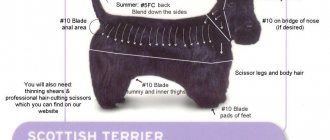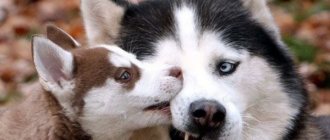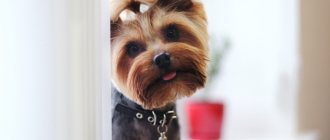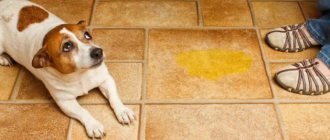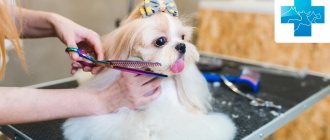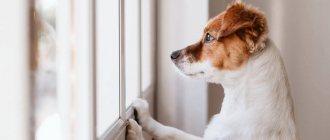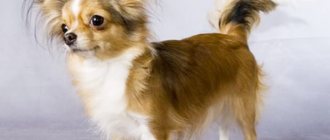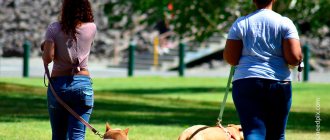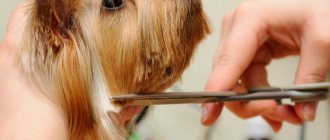Quite often, dog owners encounter problems when trying to trim their animal. Usually a calm and friendly dog reacts sharply to scissors and clippers, spins around and does not let itself be handled, growls and shows its teeth. This behavior is not considered normal and indicates major psychological problems in the puppy.
In most cases, the causes of aggression during grooming lie in childhood. The puppy was simply not trained to this procedure according to all the rules, they were not shown how to behave, or they caused injury through their wrong actions.
An aggressive dog needs to be cut.
Grooming a spaniel has always been a challenge for us too. Especially the paws. I had to take each strand in my hands and slowly cut it off with scissors. Then they cut it with a mechanical clipper, because... The dog could not stand the noise of the vibrations of the electric machine. The paws were clipped only with a muzzle and scissors.
Another tip: let one person do the haircut! And at this time, even if no one comes close, you lock yourself in the room so that you can’t even hear someone else’s presence. It's even better when there's no one in the house. This helped us because... There was no one to stand up for the dog and she had to put up with the fact that she was being cut.
Place it on a high table, and move the table towards the window so that he looks out the window, he will have something to occupy himself with, and you will have something extra. lighting + the dog realizes that he can only jump out the window). As a radical method, there are Velcro strips that can be used to tighten the paws together in pairs. If you put him on his side, he will no longer be able to stand up on his own.
It is better to take breaks while cutting. I used to be able to groom a dog for up to 7 o'clock. And even then not completely. The paws had to be trimmed the next day.
It’s easier now, she has become somewhat deaf. We bought a very powerful machine (45W Moser), which does not heat up and does not chew wool. In 1.5 hours it turns out quickly and smoothly.
And you need to do all this boldly, so that the dog understands that it will have no chance of getting rid of it. And cut regularly to prevent tangles from appearing. At least three times a year.
Only registered users have the ability to start new topics. Register and log in to the site by entering your username and password on the right side of the window, and you can start a new topic.
Before visiting the forum, read the topic: “How to properly consult a veterinarian,” as well as the list of answers to frequently asked questions, this will help you save your time and get an answer to your question faster. Pay special attention to the document: Symptoms of animal diseases. Perhaps in your situation you cannot expect an answer on the forum, but you need to urgently call a doctor or take the animal to a veterinary clinic!
Before joining the forum, read the following sections, this will help save your time and quickly get an answer to your question:
Requirements
According to the requirements of the breed standard, certain evaluation criteria for appearance are established for the Miniature Schnauzer. For exhibition, the dog must be trimmed in the back area, from the back of the head to the croup. The rest of her body can be trimmed.
It is worth considering why trimming is used. The peculiarities of the coat of some dogs, which include the miniature schnauzer, imply faster growth of guard hair with a relatively short and weak down. Since the fur not only forms, but also dies, its abundant retention on the body interferes with the normal formation of a new coat.
The dog looks sloppy and significantly loses its appearance - in comparison with its brothers freed from excess undercoat. The hard awn, due to the lack of shedding, also looks unpresentable and loses its shine and shine.
The multi-layered coat of a miniature schnauzer is associated with the unevenness of its growth. Mature, ripening and young awns remain together on the dog's back and need to be thinned out. When trimming, a special knife is used to pluck out exactly those hairs that are no longer needed. When shearing, the fluff is simply cut off completely, the fur does not look natural, which is very noticeable in the ring. The exhibition length of a Miniature Schnauzer’s “coat” should be no more than 1.5 cm.
When carrying out trimming, it is important to remember to adhere to deadlines. When preparing for an exhibition, the first treatment is carried out no less than 60 days before the show, and the second treatment is carried out 2 weeks before. This allows you to achieve the correct length of hair on the back, ensuring the preservation of the aesthetics of the breed within the current standard.
In black dogs with a brown undercoat, the intensity of hair growth is higher - they need trimming up to 7-8 times a year, every 1.5 months
This allows you to achieve the correct length of hair on the back, ensuring the preservation of the aesthetics of the breed within the current standard. Black dogs with a brown undercoat have a higher intensity of hair growth - they need trimming up to 7-8 times a year, every 1.5 months.
Why is this necessary?
In non-shedding and soft-haired breeds, the fur grows throughout its life (like human hair). If it is not cut, the pet will no longer look attractive and will acquire a whole range of problems: tangles, dermatitis resulting from them, scratching, wounds, secondary infections of the skin, parasites. The hair growing in the ears will develop pathogenic microorganisms that cause inflammation and ear disease.
The fur around the eyes and the beard of some breeds should be hygienically trimmed at least once every 2-4 weeks. The paws are also trimmed between the toes, as dirt and debris stuck to it cause discomfort and sometimes pain to the dog. Biological contaminants accumulate around the anus, especially in long-haired dogs, which can smell bad, spoil the dog’s appearance, and cause irritation or inflammation.
Any owner can trim, shorten, and give a hygienic haircut at home. But it is better to entrust exhibition grooming to professionals, at least at first.
Useful tips
You shouldn’t cut your dog’s hair too short, as the fur serves not only an aesthetic function, but also a protective one. Without the required length of hair, the animal may freeze or overheat. Insufficiently protected skin is susceptible to injury, parasite bites, scratching, and inflammation.
If you doubt your abilities or your pet is a show-class dog taking part in exhibitions, attend several master classes where they will tell you and clearly show you how to cut a dog’s hair at home. Thus, by avoiding unnecessary stress for the animal, you can save considerable amounts on show grooming. Regular grooming and a good haircut will help maintain a beautiful, healthy coat and excellent appearance for your pet.
Getting ready for a haircut
In order for the procedure to be safe, successful, and the result to meet your expectations, you need to follow simple rules.
Accustom the dog to the procedure
The most important thing is to teach your pet to calmly endure all manipulations. This needs to start from an early age. You should comb, wash and dry your baby carefully, without causing him discomfort or pain, and be sure to reward him with a treat after the procedure. You can read more about this in the article “Caring for Dog Coat.” So that you can safely use the machine at home, the dog should not be afraid of it. During the game, you can turn on the instrument so that your pet “gets acquainted” with the buzzing object. After several times the animal will stop paying attention to it, and you will be able to use the device for its intended purpose.
Preparation
Before the procedure, take your baby for a walk and feed him so that he can stand quietly for a while and allow the manipulations to be carried out. In advance, just before the haircut, comb your pet well, wash it with a special shampoo with emollients (balm, conditioner), dry it with a hairdryer or let it dry naturally and comb it thoroughly. You cannot cut a shaggy or wet dog - the result may be unpleasantly surprising.
Place and tool
To cut your dog's hair at home, you need to select and prepare a place. It is more convenient to do this on a high, flat surface, such as a table. Workplace lighting plays an important role. You must be able to see clearly what you are doing. Provide access to the table from all sides so that the pet can stand quietly in one place and you can walk around it. Cover the table with a thin rubber or silicone mat that your dog's paws won't slip on.
Prepare a comb - an ordinary thin single-row, preferably metal, and brushes that you use in everyday care. Scissors must be professional, hairdressing, well sharpened. A regular hair clipper won't work either. This should be a special grooming tool. No need to purchase an expensive professional model. A simple animal clipper or scissors will be enough.
How to properly cut a dog's hair
For professional grooming and for doing your own haircut at home, there are conditions that must be met.
All cuts are made in the direction of hair growth, the tool is held strictly parallel to the surface being treated to avoid injury. The only exception is trimming poodles' paws.
Hygienic haircut
This type of haircut includes treatment of the area around the eyes, muzzle (beard, mustache), ears, groin, armpits, area around the anus, genitals and paws. Large areas – the belly and butt – are easiest to cut using a clipper with a 4-5 mm nozzle. If you use scissors, hold them with the ends down and make short, even vertical cuts. Folds in the skin should be stretched and cut at a sufficient distance from the skin to avoid injury. For long-haired pets, a hygienic haircut is done in such a way that the long outer hair hides the cut areas.
Using small, well-sharpened scissors, carefully trim excess hair around the eyes and remove all hair from the ears. If necessary, you can also shorten the coat on the outside. If you use a clipper, smoothly draw a line from the eyes to the nose, holding the dog tightly by the mouth, but at the same time try to speak gently to him to calm him down. The paws should be combed well and everything that protrudes beyond the pads should be cut off, and the hair between the toes should also be trimmed. But don't try to cut too deep - you could injure your dog.
Hair straightening and shortening
Many dog breeds need to regularly trim their beard and long hair on the sides - this can be done at home with scissors. Try to make cuts in one precise motion, holding the scissors parallel to your body. If it doesn’t work, carefully move from left to right, trying to keep a straight line and without lifting your hands.
The fur on the paws is cut with oblique cuts, holding the scissors vertically, ends down, giving it the desired length and shape. After this, you need to comb the dog and cut off any stray hairs.
Using a machine, using 3-5 mm nozzles, you can remove excess hair from the back and sides. You should move in the direction from the head (base of the neck) to the tail, and on the sides - from top to bottom. Fur on the belly should be removed with extreme caution so as not to injure the nipples and delicate skin in this area. If this is your first experience with a machine, you can carefully trim the hair in the area of the nipples with scissors and then smoothly align the transition line with the machine.
Main stages
At the preparatory stage, it is recommended to bathe the dog, thoroughly washing the coat with hygienic shampoo, drying and combing the coat and undercoat with a comb or comb.
The next stage is a hygienic haircut, which involves trimming split ends and cutting off hair in visible areas in the area of the ears, paws, eyes, nose, genitals, and torso.
To remove hair in the genital area and on the abdomen, use a trimmer. These procedures require the master to be extremely attentive and careful to avoid inadvertently injuring the animal.
Hair on the paws, tail and body can be removed using either the same trimmers or regular scissors.
In most cases, it is recommended to leave the height of the coat on the main areas of the body at least 20 mm.
Why trim your dog's nails?
The vast majority of urban four-legged animals spend only a short time on the street. They live most of the day in apartments where slippery parquet, linoleum or soft carpet do not allow the nail plate to wear down to its natural state. Because of this, it grows regularly and problems arise.
Indications for manicure
If the dog does not live on the street, trimming its nails is a mandatory procedure. What are the consequences of not getting a manicure?
Experienced dog breeders recommend that novice owners consult with a veterinarian or groomer before performing any manipulation. A professional will advise what length to leave, suggest an algorithm of actions and even conduct a master class on trimming.
Structure of a dog's claw
It is necessary to understand the anatomy of the paw and claw in order to do a dog manicure without unnecessary trouble.
An animal's claw has a part with blood vessels and nerve endings called the claw bed. If you touch him, the sensation will be equivalent to cutting off a piece of living skin from a dog. Therefore, you can cut only the overgrown and keratinized part - it is clearly visible in the light. If the fur between your toes interferes with your vision, carefully trim that too.
Different dog breeds have different claw shapes:
The cutting principle will remain the same, but tools of different sharpness and shape may be required.
How to train a dog to trim its nails
Breeders with many years of experience and veterinarians believe that there is nothing complicated in the procedure itself if the animal has been accustomed to it since childhood. But the process of getting used to manicure becomes a difficult ordeal for most, so it’s worth preparing in advance and knowing what awaits you and your pet.
You need to get down to business in a state of calm. The dog will instantly feel nervous excitement, stress or anger of the owner and will also experience unpleasant sensations. The pet will not understand the reason for such feelings, but will begin to worry, twitch, and break free from the person’s hands. This will significantly complicate the procedure.
You should introduce your pet to the grooming procedure without haste. When the four-legged animal is in a calm, even relaxed state (after a walk and food), you should lift its paw, try it on and cut off a small tip - as if conducting a test. You should not force the animal or do it with effort and fuss. After the first success, you need to praise your pet: treat it with a tasty piece, scratch it, hug it. Having worked and consolidated the positive sensations, you can move on to the next claw.
If the dog has already had a negative experience with a manicure, then the situation will be much more complicated. Your four-legged friend will begin to get nervous just at the sight of tools, will not want to give you a paw, and may run away and hide. Then the algorithm of actions will be as follows:
At the very beginning, the process takes quite a lot of time. Sometimes it takes a whole day to finish one nail. But as soon as your four-legged friend gets used to the process, you can do everything at once.
How often do you trim a dog's nails?
It is impossible to answer this question unequivocally: the frequency depends entirely on what kind of life the pet leads. If the dog lives in a comfortable city apartment, walks in a diaper or in a litter box, runs on laminate, parquet, linoleum, carpet, then the nail plate should be trimmed quite often - as it grows.
An active pet that spends a lot of time outdoors, running and playing on hard asphalt, is cut much less often. Thanks to walks, the claws wear down on their own, and the owner only needs to make a small correction.
It’s not difficult to understand that it’s time for a haircut: the pet begins to cling to textiles in the house. Then you need to trim your claws. Another way is to visually assess the condition of the claw, which is what more experienced dog breeders usually do.
Veterinarians remind us that there are blood vessels under the hard surface. The length of the vessels depends on the length of the plate. Therefore, it should not be allowed to grow to an excessive size, otherwise in advanced cases it will become almost impossible to remove part of the claw without damaging the vessel.
General anesthesia
In severe cases, the dog may need to be placed under general anesthesia for grooming. Of course, this is done at the veterinarian's office. This is often done in cases of overly fussy dogs, or when there may be pain or a need for the dog to remain still for long periods of time. An upset dog or cat full of painful mats may be better off being placed under itself rather than being forced to remain motionless and in pain for some time.
Where to cut: at home or at the groomer?
If you regularly get your pet's hair done at a grooming salon or with a specialist, it makes sense to trust the same groomer to do the manicure. You won't have to take your pet anywhere anymore.
If your dog does not require visits to the hairdresser, you can trim its nails at home. It will be cheaper and faster.
Some individuals prefer to behave calmly only with a professional, but with the owner they become uncontrollable. In this case, there is only one way out: take the stubborn dog to the groomer. You can call him to your home - it will be a little more expensive, but it will save time and effort.
If you have never had a dog and you have no idea how to trim a dog’s nails at home, you can go to a salon the first time or two and see how it’s done. And then act independently.
Sedatives and Drug Alternatives for Grooming
Need to care for your dog, but are you too keen on your veterinarian prescribing medications? After all, drugs can have side effects, as you know, and won't cause the problem. Research shows that drug therapy is rarely a cure on its own and in most cases is indicated only as an adjuvant therapy in a behavior modification program. So you may find some natural sedatives to be a better option.
Other sedatives include products such as
DAP collars that contain calming “seductive pheromones” may also be helpful. You can try a collar, atomizer, or diffuser.
These sedatives may not be suitable for grooming at a groomer, but they can work with behavior changes that you can begin at home and at your own pace. Let's take a look at how I work with fussy dogs to make grooming more acceptable.
If it doesn't give and bites
A small dog can be swaddled in a towel or a small thick blanket. Only one paw and the tip of the muzzle should remain outside. When carrying out the nail trimming procedure, the dog must be held tightly so that it does not break free and fall or run away.
There is also another simple way: take the dog in your arms, turn it over on its back, and cut it calmly; it is not difficult to restrain a struggling dog; on its back, they are practically defenseless and powerless.
Be sure to praise your dog and give him treats! Do a couple of dress rehearsals as well: e.g. Prepare everything for the grooming and let the dog feel the moment and get used to the tools. There is no need to cut your hair the first 2-3 times, just “rehearse.”
Benadryl
A few veterinarians who do not feel comfortable prescribing certain medications or do not feel they are necessary may decide to try an easier medication first. One drug of choice is often simple Benadryl. Benadryl, also known as "Diphenhydramine" is an over-the-counter antihistamine. It is mainly used for allergies and motion sickness. When this drug is prescribed for anxiety, its use is based on the drug's ability to cause sedation and lethargy. If you've taken Benadryl before, you may be aware of its "drowsy" effect, which causes drowsiness. That's why when you take this drug, he says you shouldn't take it while "driving or operating heavy machinery."
Additional care - dog pedicure
Dogs' nails need to be cared for throughout the pet's life. This is not about worshiping glamorous fashion, but about a vital necessity. Domestic dogs are losing many of the advantages that nature originally endowed them with many centuries ago:
As a result, dogs' claws become loose, and their structure is often disturbed—proper care will solve the problem. Pedicure accessories will provide the nail plate with an even edge and a smooth surface. You can learn how to do a pedicure yourself, but you shouldn’t forget about professional services.
What you need to have in your arsenal:
When using a grinder, the risk of injury is minimal
Using an electric grinder, you can adjust your claws all year round. Then they do not have time to grow, which means there is no need for a haircut.
An untrained dog is irritated by the vibration and characteristic sound of the device. But this can also be solved. One or two procedures, and the pet will resign itself, making sure there is no reason to worry.
How to properly trim a dog's nails with a nail clipper
The manipulation of shortening the claw should take place with minimal discomfort for the pet. To prevent the procedure from causing unnecessary anxiety, it is important to know the sequence of actions:
Black claws are considered the most difficult to trim. On beige and light-colored claws, it is easy to see blood vessels, which will greatly facilitate the process. The pulp appears as a darker area.
You can see the approximate location of the pulp with blood vessels on the black claw by the location of the hollow. Sometimes the depression is on the side. Veterinarians advise focusing on the hollow and pruning very carefully, not trying to cut everything off at once.
Different breeds
Using the above tips and recommendations, you can trim the nails of almost any dog, regardless of its breed and size. However, there are breeds in which the process of trimming nails has some peculiarities. All these dogs have one thing in common: they are classified as indoor and decorative dogs and are very small in size. These include the Yorkie, Chihuahua, Miniature Spitz and Toy Terrier.
How to cut hair for small breed dogs?
York
Let's figure out how to properly cut a Yorkie's (Yorkshire terrier) nails. After all, their claws need to be trimmed regularly not only for the sake of beauty, but also to avoid health problems. If the claws grow too long, they can curl up and grow into the pads of the toe.
Chihuahua
A note for those who are interested in how to properly cut a Chihuahua's nails:
IMPORTANT ! You should not forcefully cut your Chihuahua's claws. If the dog gets scared or feels rough treatment, then next time it will be much more difficult to persuade it to undergo this procedure.
Spitz
Like all other dogs, Pomeranians need to have their nails trimmed from time to time. It is better to do this with guillotine-type nail clippers for small dogs.
Before trimming, trim the hair on your dog's toes if necessary.
To carefully trim the claw and avoid touching the pulp, take the Spitz's paw, press on the pad and hold the claw up to the light. This will help determine where the keratinized part ends. If you still can’t see the pulp, then just start cutting about 1 mm at a time until you see a point on the cut. After this, clean the cut with a file.
Toy terrier
Toy puppies begin to trim their claws already at one and a half weeks of age and do this every 15-20 days. Adult dogs of this breed have their nails trimmed every 20-30 days.
It is necessary to trim the toy terrier's nails, if only because due to the small weight of these dogs, their claws do not wear down even while walking on asphalt or gravel, no matter how long the toy walks.
Place the dog on your knees and, taking its paw, pressing on the pad, extend the claw, then cut it off by 3-4 mm. It would be enough.
ATTENTION ! Toy terriers, despite their small stature, are distinguished by rare stubbornness. If you give up ahead of time and let him go until the end of the procedure, then he will not allow you to trim his claws; on the contrary, he will resist even more.
Dachshund
First aid for injuries
Despite full compliance with the rules and compliance with the operating algorithm, even an experienced owner can make a mistake. This can be caused by various circumstances: a sharp sound outside the window, a dull nail clipper, or excessive nervousness of the pet. Don't get upset - it's important to remain calm, apologize to the dog and treat the wound.
Pulp cut
Trimming too short greatly increases the risk of damaging blood vessels. This causes severe pain and excessive bleeding. The main task of the owner in case of pulp injury is to urgently stop the bleeding. In addition, it is necessary to calm your four-legged friend - his reaction will be panic and a desire to run away.
The owner should try to distract the animal, switch its attention to something else - perhaps to a toy or a pre-prepared treat. There is no point in screaming at this moment, as the dog is already scared and in pain. Next you need to treat the wound with hydrogen peroxide. It is not recommended to use alcohol-based solutions - they will only increase the pain and cause a burning sensation.
Antiseptic powder has a good effect. Veterinarians advise having this drug in your pet first aid kit. It is used to treat open wounds and abrasions and copes well with injuries caused during trimming of the nail plate.
Claw detonation
A similar nuisance arises in the case of nervous and uncertain actions of the dog breeder. The dangerous combination of slow compression of the nail cutter along with an unexpected and sharp jerk of the limb during shortening leads to a poor result. Damage to the skin and soft tissues is accompanied by severe pain and fear, and not only from the dog - the owner also experiences nervous shock. However, you should gather your strength and provide first aid to the victim:
When transporting an animal to a veterinary clinic, cold should be applied to the damaged area, but at the same time avoid frostbite of the limb.
Source
Acepromazine
After unsuccessful attempts with Benadryl or melatonin, some veterinarians recommend Acepromazine. Now, this is a much more potent drug, but with higher potency there is an increased chance of side effects . This drug can cause what is called a paradoxical reaction, which means that it causes the opposite of what the drug is intended to do. In this case, instead of relieving anxiety, your dog may become hyperactive and even aggressive!
